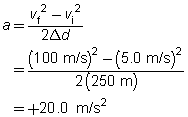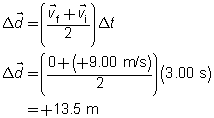Module 1—Motion
 Explore
Explore
In previous lessons you used graphs to assist in analyzing the motion of objects. In simple cases, this is all you need. You’ve seen that graphical analysis is a powerful tool. When used to solve complex motion problems involving acceleration, velocity, and displacement, graphing often takes too long and is prone to error. Using equations can help with these problems, so you will now investigate some equations that are useful in problem solving.
Equations Involving Acceleration, Velocity, and Displacement
To begin, recall the basic equations that describe average velocity and acceleration.
![]()
![]()
Using only these two equations and some graphical analysis, several other useful equations have been derived for solving problems involving acceleration, velocity, and displacement. You will learn more about these equations and how they are used in the Watch and Listen and as they are used in the sample solutions provided.
 Watch and Listen
Watch and Listen
There are six equations for motion. You can view their derivation or how they are solved in this animation.
Here are the six kinematic equations for motion:
Equation 4
![]()
Equation 1
![]()
Equation 5
![]()
Equation 2
![]()
Equation 6
![]()
Equation 3

Note that equation 1, ![]() , may be used for both uniform and non-uniform motion.
, may be used for both uniform and non-uniform motion.
Equations 2 to 6 are only used when the object is undergoing uniformly accelerated motion such as when it is subjected to constant acceleration.
In the equations above,
 is initial velocity.
is initial velocity.  is the displacement.
is the displacement.- Δt is the time interval.
 is average velocity.
is average velocity. is the final velocity.
is the final velocity. is the acceleration.
is the acceleration.
Now that you have identified these six equations and when they can be used, how do you approach problem solving using these equations?
A Problem-Solving Method
Use the GRASP method (acronym for Given, Required, Analysis, Solution, Paraphrase) that you have seen in the previous lessons in solving kinematic problems with equations:
-
Given: Read the question. Identify and write down the known variables. Make a diagram, if needed, to keep everything straight.
-
Required: From the question, extract and write down what is being asked for (the unknown variable).
-
Analysis: Decide how to best solve for the required quantity. Select and write down the equation that contains the variables listed. (It does not matter what order the variables are in or which one is unknown.) Specify the positive direction, if needed.
-
Solution: Manipulate the equation, if necessary, so that the unknown is isolated.
-
Substitute in the known variables along with their units.
-
Solve for the answer.
-
Remember to include units and direction, where appropriate (i.e., vector quantities). Round the final answer to the correct number of significant digits, consistent with the rules on page 877 of the textbook.
-
Paraphrase: Answer the question in a proper English sentence.
The following series of examples demonstrates this method. Reference these examples as you work on the Try This questions for your Module 1: Lesson 5 Assignment.
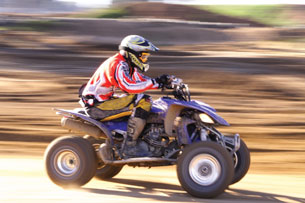
© sculpies/shutterstock
A quad is in motion.
Example Problem 1: A quad travelling at +10.0 m/s accelerates until the final velocity becomes +20.0 m/s. If the time interval was 5.0 s, determine the quad’s displacement.
Given (Known Variables) |
 |
|---|---|
Required (Unknown Variable) |
the displacement ( |
Analysis |
The equation that uses all the variables is  . . |
Solution |
 |
Paraphrase |
The displacement of the quad is +75 m. |
 Self-Check
Self-Check
SC 1. Go to page 53 of your textbook and complete question 6 of “1.5 Check and Reflect.”
 Self-Check Answer
Self-Check Answer
SC 1.
Given

Required
the skidding distance (![]() )
)
Analysis and Solution
Distance is a scalar quantity, so direction is not a factor. The magnitude of displacement equals distance. Therefore, the equation that uses all the variables is
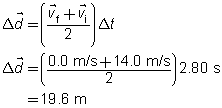
Paraphrase
The skidding distance is 19.6 m.
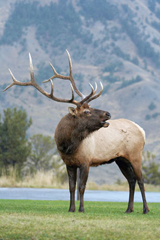
© Wesley Aston/shutterstock
 Read
Read
Read “Example 1.12” on page 47 of your textbook to see an example of manipulating the equation to isolate the unknown variable. If you feel comfortable manipulating variables, cover the solution to “Example 1.12” and calculate the answer. Then check your work.
 Self-Check
Self-Check
SC 2. Solve practice problem 2 for “Example 1.12” on page 47 of your textbook.
 Self-Check Answer
Self-Check Answer
SC 2.
Given
![]() = 20 km/h [N]
= 20 km/h [N]
![]() = 1.5 m/s2 [N]
= 1.5 m/s2 [N]
Required
the maximum velocity of the elk (![]() )
)
Analysis
Choose north to be the positive direction. Convert the initial velocity to m/s. The final velocity will have to be converted back to km/h.
Use the equation ![]() , and manipulate it to isolate
, and manipulate it to isolate ![]() .
.
Solution


= (5.56 m/s) + (1.5 m/s2)(9.3 s)
= 5.56 m/s + 13.95 m/s
= 19.5 m/s

Paraphrase
The maximum velocity of the elk is 70 km/h [N].
 Module 1: Lesson 5 Assignment
Module 1: Lesson 5 Assignment
Remember to submit the answer to TR 1 to your teacher as part of your Module 1: Lesson 5 Assignment.

© shahar choen/shutterstock
 Try This
Try This
TR 1. A homing pigeon starts from rest and accelerates uniformly at +4.00 m/s2 for 10.0 s. What is the velocity after the acceleration?
Example Problem 2: A car starts from rest and accelerates at +5.0 m/s2 until it has travelled +250 m. What is the time interval?
Given (Known Variables) |
 |
|---|---|
Required (Unknown Variable) |
the time interval (Δt) |
Analysis |
The equation that uses all the variables is It will have to be manipulated to isolate Δt. Since |
Solution |
Now use magnitudes only because you cannot divide vectors.
|
Paraphrase |
The time interval is 10 s. |

©Ian McDonnell/iStockphoto
A motorcycle is on the road.
 Read
Read
Read pages 48 and 49 of your textbook. Note how the GRASP method is used with the equation in “Example 1.13.”
 Self-Check
Self-Check
SC 3. Solve practice problem 2 for “Example 1.14” on page 50 of your textbook.
 Self-Check Answer
Self-Check Answer
SC 3.
Given
![]() = 100 km/h
= 100 km/h
![]() = –0.80 m/s2
= –0.80 m/s2
Δt = 1.0 min = 60 s
Required
the distance the motorcycle travelled (Δd)
Analysis and Solution
The equation that uses the variables is ![]() . Distance is not a vector quantity, so the final answer will not require direction. Convert the initial velocity to m/s.
. Distance is not a vector quantity, so the final answer will not require direction. Convert the initial velocity to m/s.


Paraphrase
The distance the motorcycle travelled is 2.3 x 102 m.
 Module 1: Lesson 5 Assignment
Module 1: Lesson 5 Assignment
Remember to submit the answer to TR 2 to your teacher as part of your Module 1: Lesson 5 Assignment.
 Try This
Try This
TR 2. A car has an initial velocity of +30.0 m/s and undergoes an acceleration of –5.00 m/s2 for 5.00 s.
- Find the displacement after the acceleration.
- Find the velocity after the acceleration.
 Read
Read
See how another kinematic equation was derived and how it is used to find the answer to a problem by reading the bottom of page 51 and “Example 1.16” on page 52 of your textbook. Cover the solution to “Example 1.16,” and calculate the answer. Then check your work.
Example Problem 3: An object accelerates from +5.00 m/s to +100 m/s. If the object travelled +250 m during this time, what was the acceleration?
Given (Known Variables) |
 |
|---|---|
Required (Unknown Variable) |
the acceleration ( |
Analysis and Solution |
The equation containing all the variables is
|
Paraphrase |
The acceleration was +20.0 m/s2. |
Example Problem 4: A ball rolls up an inclined plane with an initial upward velocity of +9.00 m/s and stops rolling upward after 3.00 s. Then it begins to roll back down the plane. What was the displacement after 3.00 s?
Given (Known Variables) |
 |
|---|---|
Required (Unknown Variable) |
the displacement ( |
Analysis and Solution |
Choose up the ramp as the positive direction. The equation to use is
|
Paraphrase |
The displacement after 3.00 s was +13.5 m. |

